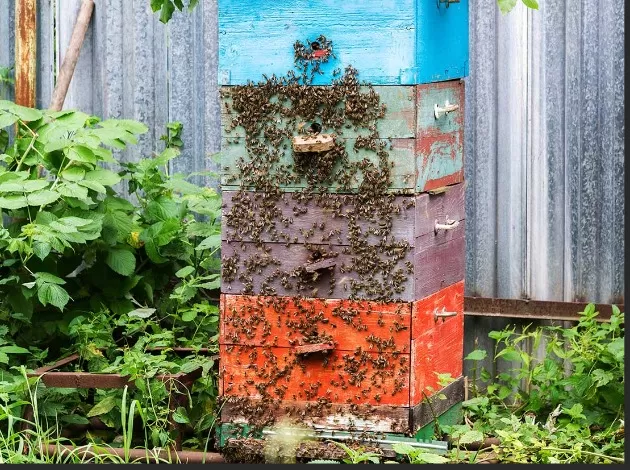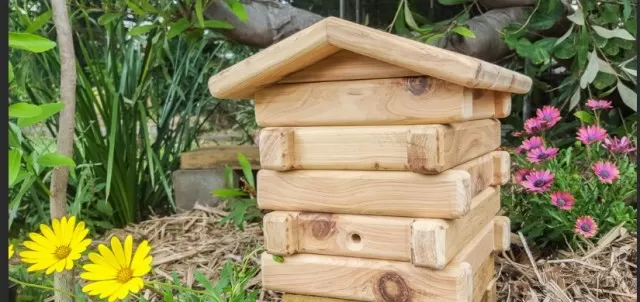Backyard Beekeeping: A Guide to Homemade Honey. In recent times, backyard beekeeping has become a trending and rewarding hobby for nature enthusiasts and eco-conscious individuals alike.
Not only does it offer a unique way to connect with nature, but it also contributes to the essential role of pollinators in our ecosystem. If you’re considering venturing into the world of backyard beekeeping, here’s some must-know information and valuable tips to help you embark on this sweet and fulfilling pursuit. Backyard beekeeping can be a truly rewarding and enriching experience. As you embark on this sweet journey, remember that patience, knowledge, and respect for these incredible creatures are key. With the right approach and dedication, you’ll soon find yourself basking in the joys of being a backyard beekeeper and making a positive impact on the environment!
Supporting Our Pollinators: The Growing Trend of Backyard Beekeeping

In recent years, the practice of backyard beekeeping has witnessed a remarkable surge, as an increasing number of individuals recognize the importance of supporting pollinators, especially during challenging times.
Honeybees and other pollinator species have faced a concerning decline, primarily attributed to factors like extensive pesticide usage and the loss of their natural habitats – some of which remain shrouded in mystery. Curiously, researchers are even exploring whether the rise in cell phone usage plays a role in this decline.
The impact of this decline is profound, as approximately 70 percent of the world’s food crops rely on pollination.
As a result, fostering healthy pollinator populations has become an urgent priority. Backyard beekeeping emerges as a practical solution, providing enthusiasts with the opportunity to play a vital role in preserving these essential creatures while reaping the benefits of their efforts.
Embracing beekeeping as a rewarding and eco-friendly hobby not only contributes to the well-being of our environment but also offers a sweet reward in the form of homemade honey.
However, venturing into this endeavor isn’t as simple as purchasing bees and setting up a hive. Successful beekeeping demands adherence to rules, understanding and mitigating risks, and conducting thorough research.
If you’re intrigued by the prospect of backyard beekeeping, take the initiative to delve into the secrets of successful apiculture.
By doing so, you will not only gain valuable insights into the delicate world of bees but also actively participate in safeguarding our precious pollinators for generations to come. Let us embark on this journey of exploration and stewardship, fostering a brighter and more sustainable future for both bees and humankind alike.
So, start clicking to learn the fascinating and crucial art of beekeeping today.
Beekeeping Etiquette: Engage with Your Municipality and Neighbors
Before you embark on your journey as a backyard beekeeper, it’s essential to consider the rules and sentiments of your local community.
Despite honeybees being beneficial to the environment, some towns and cities enforce strict regulations that prohibit their presence in residential backyards. To ensure compliance and avoid any potential legal issues, it is crucial to reach out to your town government to determine if beekeeping is permitted in your area.
Moreover, cultivating open communication with your neighbors is equally vital.
Although honeybees are generally gentle and unlikely to cause harm, a hive with thousands of buzzing insects might understandably cause concern for some individuals. Being transparent and considerate towards your neighbors can go a long way in fostering understanding and cooperation.
When engaging with your neighbors, educate them about the benefits of honeybees to the local ecosystem and food production.
Assure them that you plan to maintain a well-managed and responsibly placed hive to minimize any disturbances. Most people will likely appreciate your effort to include them in the decision-making process and may even become supportive of your backyard beekeeping endeavor.
Remember, promoting a positive image of beekeeping can help break stereotypes and dispel misconceptions.
By being a responsible and considerate beekeeper, you can help build a more supportive environment for honeybees and encourage others to join in conserving these essential pollinators.
So, take the initiative to check with your municipality and talk to your neighbors before setting up your backyard hive.
It’s a small but crucial step towards creating a harmonious and bee-friendly community, where both you and the pollinators can thrive together.
Dive Deep into Knowledge: The Essential Preparations for Beekeeping

Embarking on the journey of beekeeping requires a solid foundation of knowledge, and fortunately, this is a subject with a wealth of resources available.
With extensive literature, articles, and online content, you will find no shortage of material to explore. Websites, forums, and YouTube channels dedicated to beekeeping offer valuable insights and practical guidance from experienced enthusiasts.
Make the most of your time before ordering your bees by conducting thorough research.
Familiarize yourself with various aspects of beekeeping, including hive construction, hive maintenance, bee biology, bee behavior, seasonal management, pest and disease control, and best practices for honey extraction. Understanding the different types of hives and their pros and cons will help you make an informed decision about the most suitable hive for your needs.
Apart from theoretical knowledge, take advantage of the vast array of instructional videos available online.
Visual resources can provide a clearer understanding of various beekeeping techniques and procedures. Watching experienced beekeepers in action will aid in visualizing the practical aspects of managing your own hive.
Even if you feel well-prepared, keep in mind that beekeeping is an ongoing learning experience.
Even experienced beekeepers continue to discover new insights from their hives. The behavior of bees can be complex and variable, influenced by factors like climate, flora, and local environment.
Staying open to learning and adapting your approach will contribute to your success as a beekeeper.
As you delve into your research, ensure you have a strong foundation in the key topics before your bees arrive.
This includes understanding hive components, how to handle bees safely, how to inspect a hive, and recognizing signs of a healthy or struggling colony. Having this essential knowledge will boost your confidence and ensure a smooth start to your beekeeping journey.
Remember, the more you know, the better you can care for your bees and the more rewarding your experience will be.
So, dedicate time to enrich your understanding of beekeeping and be well-prepared to embrace the joys and challenges that come with nurturing these fascinating pollinators.
Invest in Quality: Choosing the Right Beekeeping Equipment
When it comes to beekeeping, investing in high-quality equipment is A Key factor in ensuring a successful and enjoyable experience.
While beekeeping may not be as costly as some other hobbies, it is essential to prioritize the durability and functionality of your equipment.
If you’re not inclined to construct your own hive, consider purchasing hive bodies with finger joints.
These joints provide added strength and stability to the hive structure, ensuring it can withstand the rigors of bee activity and environmental conditions. A sturdy hive will not only protect your bees but also contribute to the longevity of your equipment.
To streamline your beekeeping preparations, look for comprehensive kits that include essential tools such as the hive tool, gloves, and smoker.
Buying these items as a kit eliminates the need to search for each component individually, saving you time and effort. Make sure to choose kits that offer high-quality tools made from materials that are both functional and comfortable to use.
When selecting gloves, opt for those designed explicitly for beekeeping, offering adequate protection while allowing for dexterity.
Hive tools are invaluable for prying open hive components, scraping off propolis, or separating frames, so having a reliable and durable tool is essential.
The smoker is another indispensable tool used to calm the bees during inspections by releasing a gentle puff of smoke.
Look for smokers that are well-constructed and designed for efficient smoke generation, as a properly managed smoker can significantly reduce the likelihood of agitating the bees.
Remember, beekeeping equipment is an investment that directly impacts the well-being of your bees and the efficiency of your management practices.
Cutting corners on quality may result in equipment failures or unnecessary frustrations down the line. Prioritize obtaining dependable, high-quality gear, and you’ll be rewarded with smoother beekeeping sessions and greater peace of mind.
So, take the time to research and source the best beekeeping equipment available, ensuring you’re well-prepared to embark on this rewarding journey with confidence and success.
Choosing the Perfect Spot for Your Beehive: Considerations and Recommendations

Selecting the ideal location for your beehive is crucial for the well-being of your bees and the success of your beekeeping endeavor.
While a hive doesn’t require a large area, it is essential to provide them with a peaceful and secure environment. Here are some considerations and recommendations to help you find the best site for your new hive:.
Sunlight and Shade: Bees thrive in areas that receive ample sunlight, especially during the morning hours.
Aim to place your hive in a location that receives at least six hours of sunlight per day. However, it’s also essential to provide some afternoon shade during hot summer days.
This balance ensures that your bees stay active and productive without overheating.
Wind Protection: Avoid placing the hive in an area that is excessively windy.
Strong winds can stress and disorient the bees, making it difficult for them to navigate and collect food. Providing some natural windbreaks, such as hedges or fences, can help create a more sheltered environment for your hive.
Water Source: Bees need access to water for cooling the hive and diluting honey stores.
Ensure there’s a nearby water source, such as a shallow birdbath or a small pond, where they can safely access water without drowning.
Distance from Human Activity: While bees are generally not aggressive and won’t bother children or pets unless provoked, it’s still best to place the hive away from high-traffic areas in your yard.
Select a spot that is not frequently frequented by people or pets to minimize disturbances to both your bees and your family members.
Zoning Regulations: Check with your local municipality for any zoning regulations or restrictions regarding beekeeping in residential areas.
Ensure that you comply with any rules to avoid potential issues.
Accessibility: While you want to keep the hive away from human activity, make sure it is still accessible for regular inspections and Maintenance.
Ensure there’s enough space around the hive for you to work comfortably without disturbing the surrounding environment.
Consider Your Neighbors: While bees are essential pollinators, some neighbors may have concerns about having a beehive nearby.
As discussed earlier, communication is key. Inform your neighbors about your beekeeping plans and address any questions or concerns they may have.
By carefully considering these factors and finding the perfect spot for your beehive, you’ll be setting the stage for a harmonious coexistence with your new buzzing friends.
Providing a safe, sunny, and sheltered environment will help your bees thrive, benefiting both your garden and the surrounding ecosystem.
*The information is for reference only.